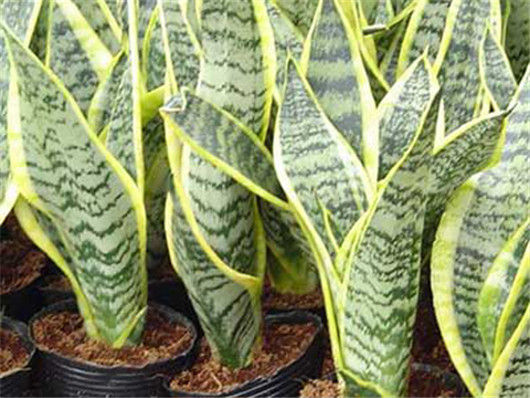The breeding methods and matters needing attention of tiger orchid, and what are the breeding methods of tiger skin orchid?
Tiger skin orchid is a common potted plant, also known as tiger tail orchid, thousand years old, is a perennial herb. Tiger Pilan has a strong air purification ability, can absorb more than 80% of indoor harmful gases, especially formaldehyde, and can effectively remove sulfur dioxide, chlorine, ether, ethylene, carbon monoxide and other harmful gases. Suitable for indoor breeding, beautifying the environment and cleaning the air.

In fact, any kind of plant breeding is a method, and you have mastered the right method. Your tiger Pilan can also grow quickly or blossom. Let's take a look at the specific breeding methods and preventive measures of Tiger Pilan.
Propagation methods of Polygonum cuspidatum: ramets and cuttings
First, Tiger Pilan's growth habits; in fact, Tiger Pilan is still quite adaptable, like a warm and humid environment, can withstand drought, like light can also shade, soil requirements are not high, sandy soil with good drainage is fine.
Second, the breeding methods and matters needing attention of tiger skin orchid
1. Tiger skin orchid pot soil requirements: the above said tiger skin orchid on the soil is not strict, pay attention to loose, there is no stagnant water. Potted soil can rot with leaf soil: the ratio of garden soil to sand is 1:1:1. Breathing without water is the key requirement of soil distribution. Tiger skin orchid is dry and afraid of water. Once the basin soil is too wet, it can easily lead to root rot.
2, tiger skin orchid light requirements: Tiger skin orchid is a potted plant, but also can resist yin deficiency. It is best to put it in a place where there is direct light when breeding. If there is no direct light, it should be placed in a bright position near the sun. Indoor breeding, long-term exposure to the sun, should be moved to the sun regularly, add light, so as not to cause the leaves yellowing due to lack of light.
3. Tiger Pilan watering: Tiger Pilan West is wet and can stand drought. When watering, it can be adjusted according to climate change and growth conditions. During the vigorous growth period in summer, the basin should be kept moist. In winter, water should be controlled to keep the potted soil dry, and it should be watered in spring and autumn. Follow the principle of dry and wet.
4. How to fertilize: there is little demand for fertilizer for Liliaceae plants, and the strong growth of Hu Pilan can be ensured by applying thin liquid fertilizer every 15 days during the growing period.
5, tiger skin orchid pruning: when the planting method is correct, tiger skin orchid still grows very fast, so when it is full in the basin, it needs to be pruned to cut old leaves and over-luxuriant areas to ensure that tiger skin orchid can get more sunshine and more room for growth.
6. Tiger skin orchid temperature requirements: Tiger skin orchid likes a warm environment, the suitable growth temperature is 20-30 °C, and the winter temperature is not less than 10 °C. Otherwise, it is vulnerable to frost. In winter, we must pay attention to heat preservation.
7, tiger skin orchid change pot time: potted tiger skin orchid should be replaced every two years. The basin can be carried out in spring and the original old soil can be removed. Only about 1amp 3 was left, and fertile new soil was added. This will ensure the nutritional supply of tiger Pilan.
8. Prevention and treatment of tiger skin orchid diseases and insect pests: Tiger skin orchid common diseases, mainly leaf spot and anthracnose, can be sprayed with 50% carbendazim for treatment, common pests are weevil, 50% can be used to kill chrysanthemum EC spray a thousand times.
- Prev

Cucumber planting techniques: cultivation techniques, planting time and methods of cucumber in open field
Do you like cucumber as a vegetable? In the consumer market, the demand for cucumbers is relatively large. Do you want to grow cucumbers yourself? Let's take a look at when cucumbers are planted and how to grow them. The planting time of spring cucumber is in
- Next

Introduction to the culture method of Jiuli perfume culture, the culture method of Jiuli incense and the matters needing attention
Putting a pot of green plants at home or in the office can make people feel happy. Jiuli incense is a good bonsai plant. As a hydroponic plant, it is very easy to grow, easy to survive and has a long life. What is the method of cultivating Jiuli perfume? 1. Temperature
Related
- A course of planting techniques and methods on how to grow carrots
- How to plant the latest tulips?
- Is it better to pick tea in the morning or in the afternoon? When is the best time for tea to be picked? what is the third or fifth tea?
- Launch Yuanxiao Happy combination Haocha + Tea Yuan healthy Taste
- Penghu Tourism "Fireworks 20 Parade with You"
- 2022 West Lake Happiness holds "Digital Revitalization Voucher" and draws iphone13 and laptop.
- Banqiao Fuzhou social houses are designed to change start-up combined with police elimination to create a safe and livable environment
- The convenient measure of "mechanical weeding" in Xinbei has been abused and the Agriculture Bureau has imposed heavy penalties on the illegal land consolidation.
- Changgeng University Joins Hands with Four Memory Factories to Rescue Memory Talent Shortage
- The list of Taiwan's top 100 MVP managers is listed by the Director-General of the Farmers' Association of Sanxia District.

